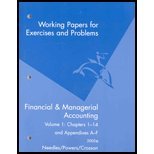Answered step by step
Verified Expert Solution
Question
1 Approved Answer
P 19-3 Various Funds- University A partial statement of financial positions of Century University is shown below. Century University Partial Statement of Financial Position 30-Jun-11
| P 19-3 Various Funds- University | ||||||||||
| A partial statement of financial positions of Century University is shown below. | ||||||||||
| Century University | ||||||||||
| Partial Statement of Financial Position | ||||||||||
| 30-Jun-11 | ||||||||||
| Assets | Assets | |||||||||
| Current funds | ||||||||||
| Unrestricted | ||||||||||
| Cash | $210,000 | |||||||||
| Accounts Receivable (less allowance for doubtful accounts, $9,000) | 341,000 | |||||||||
| State Appropriations Receivable | 75,000 | |||||||||
| Total Unrestricted | 626,000 | |||||||||
| Restricted | ||||||||||
| Cash | 7,000 | |||||||||
| Investments | 60,000 | |||||||||
| Total Restricted | 67,000 | |||||||||
| Total Current | 693,000 | |||||||||
| During the fiscal year ended June 30, 2008, the following transactions occurred: | ||||||||||
| 1.) A gift of $100,000 was recived from an alumnus on July 7, 2011. One-half of the gift was to be used for the | ||||||||||
| purchase of books for the university's libar and the rest was to be used to establish a scholarship fund | ||||||||||
| per the alumnus's request. It was also requested that the income generated by the scholarship fund be | ||||||||||
| awarded annually as a scholarship for a qualified disadvantaged student. The board decided that the funds | ||||||||||
| for the new scholarship should be invested in savings certificates on July 20, 2011. These savings certficates | ||||||||||
| were purchased on July 21, 2012. | ||||||||||
| 2.) Revenue for the fiscal period from student tuition and fees amounted to $1,900,000 During the | ||||||||||
| fiscal year, $1,685,000 of this amount was collected; $66,000 had been collected in the prior year. | ||||||||||
| The university had also reeived $158,000 by June 30, 2012, for fees for the session beginning July 1, 2012. | ||||||||||
| 3.) Durig the year ended June 30, 2012, the university collected $349,000 of the outstanding accounts | ||||||||||
| receivable at the beginning of the year. The balance was determined to be uncollectible and was | ||||||||||
| written off against the allowance account. At June 30,2012, the allowance account was increased by $3,000. | ||||||||||
| 4.) Because of late student fee payments, $6,000 in interest charges were earned and collectedd. | ||||||||||
| 5.) The state appropriation was received. Another unrestricted appropriation of $50,000 was made by | ||||||||||
| the state. This had not been paid to the university by the fiscal year-end. | ||||||||||
| 6.) An unrestricted gift of $25,000 cash was received from alumni of the iniversity. | ||||||||||
| 7.) During the year, investments of $21,000 were sold for $26,000. Investment income amounting to | ||||||||||
| $1,900 was received. | ||||||||||
| 8,) Unresstricted operating expenses were reorded at $1,777,000, $59,000 of which remains unpaid. | ||||||||||
| 9.) Restricted current funds of $13,000 were spent for authorized purposes during the year. | ||||||||||
| 10.) The accounts payable at June 30, 2011, were paid during the year. | ||||||||||
| 11.) During the year, $7.000 interest was earned and received on the savings certificats purchased | ||||||||||
| in accordance with the board's resolution [in item (1)]. | ||||||||||
| Required: | ||||||||||
| A.) Prepare journal entries to record in summary form the transactions above for the year ended | ||||||||||
| June 30, 2012. Each journal entry should be numbered to correspond withh the transaction | ||||||||||
| described above. Set up the folllowing headings. | ||||||||||
| Current Funds | ||||||||||
| Unrestricted | Restricted | Endowment Fund | ||||||||
| Accounts | Dr. | Cr. | Dr. | Cr. | Dr. | Cr. | ||||
| B.) Prepare a Statement of Activities for the year ended June 30, 2012. | ||||||||||
| C.) Prepare a statement of activities for the current funds for the year ended June 30, 2012. Include | ||||||||||
| more details about the revenues and expenses. | ||||||||||
Step by Step Solution
There are 3 Steps involved in it
Step: 1

Get Instant Access to Expert-Tailored Solutions
See step-by-step solutions with expert insights and AI powered tools for academic success
Step: 2

Step: 3

Ace Your Homework with AI
Get the answers you need in no time with our AI-driven, step-by-step assistance
Get Started


